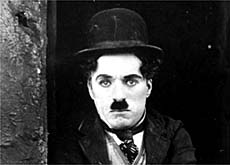The Chaplin Project

The "Chaplin Project", based in the Italian city of Bologna, has been entrusted with the task of restoring the artist's films and digitalising his archives.
The project was officially launched earlier this year even though Italian researchers and film restorers began their work in 1999.
Cecilia Cenciarelli, the co-ordinator of the Chaplin Project, spoke to swissinfo’s Dale Bechtel about its work and its aims.
swissinfo: Why has an Italian archive been entrusted with the task of restoring Chaplin’s films and compiling a digital database of his documents?
Cenciarelli: Our restoration laboratory “L’Immagine Ritrovata” is well known all over the world for its quality and application of the latest technologies. The Chaplin family was impressed by the great care we take. Italy has always had a particular love for Chaplin, and has always promoted his films and loved his persona. The Chaplin family and the Association Chaplin have shown great trust in our expertise.
“Cineteca di Bologna” is the second largest film archive in Italy and hosts one of the two existing festivals on silent cinema, “Il Festival del Cinema Ritrovato”, where archivists, professors, students, researchers and amateurs from all over the world gather each summer. It was widely felt that this was the right place and context for the Chaplin Project.
swissinfo: Can you explain what you will be doing at the Montreux archives next month?
Cenciarelli: The Chaplin Project team consists of six people, and our task is to digitalise page by page, catalogue and study all the paper materials before August 2005. To do this we have organised the transferral of a number of documents from Paris and Montreux. The paper materials come in boxes, and after several months they will be returned to Montreux.
My colleagues will travel to Montreux to finish examining all the papers and to compile a complete inventory of what is held in Montreux, as well as to exchange some boxes. “Limelight” will return home [to Montreux] and “Monsieur Verdoux” will visit Bologna!
swissinfo: How important are the Chaplin documents in Montreux?
Cenciarelli: The Montreux archives are certainly the largest of their kind and will get bigger. The Chaplin papers have travelled a lot, from California where the director had his studios to Switzerland, even though a part of it is still in Paris where the Association Chaplin is located. Once we have finished cataloguing everything all the documents [including those in Paris] will be reunited for the first time in Montreux, where they will be safeguarded under the best possible conditions.
Not only is the head of the archives, Evelyne Lüthi-Graf, one of the most competent professionals in her field but Montreux also has the best and most modern security system, and has installed a state-of-the-art climate control system to prevent the deterioration of the documents.
swissinfo: What is included in the archives that you are digitalising?
Cenciarelli: They are immensely rich and various. The collection ranges from scripts, to manuscripts, scenarios, drawings, original scores, personal letters, daily production reports, original press releases, photographs – almost 200,000 pages in all going back to the 1910s. Our aim, as a film archive and as the Chaplin Project, is to provide visibility for this beautiful and unique collection by making it accessible to researchers and students in order to keep Chaplin’s name alive.
swissinfo: What do you enjoy most about cataloguing the works and documents of Charlie Chaplin?
Cenciarelli: Our work is similar to that of an archaeologist: we feel we are making a new discovery each time a box of Chaplin documents arrives. We recently received a box which included fake French franc notes used in Monsieur Verdoux, and a letter written and signed by Albert Einstein.
swissinfo: What surprised you about the way the film-maker worked?
Cenciarelli: I really enjoy tracing back all the variations Chaplin made in his scripts – from the first draft to the final version. He made an incredible number of changes before being satisfied. He often carried an idea from the very beginning through to the end of filming and then, after two years of working on a particular scene, decided to cut it at the last minute.

In compliance with the JTI standards
More: SWI swissinfo.ch certified by the Journalism Trust Initiative








You can find an overview of ongoing debates with our journalists here . Please join us!
If you want to start a conversation about a topic raised in this article or want to report factual errors, email us at english@swissinfo.ch.